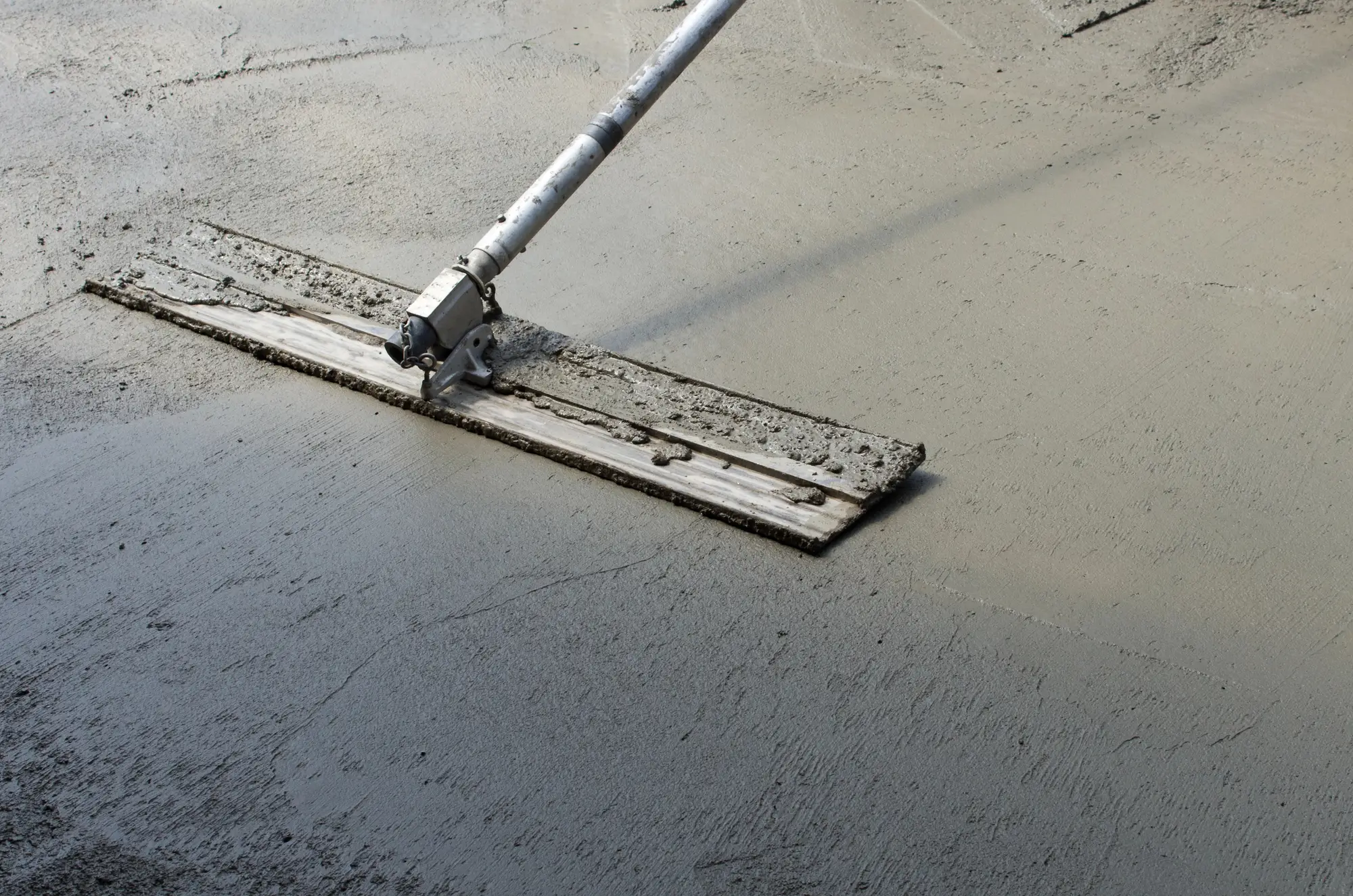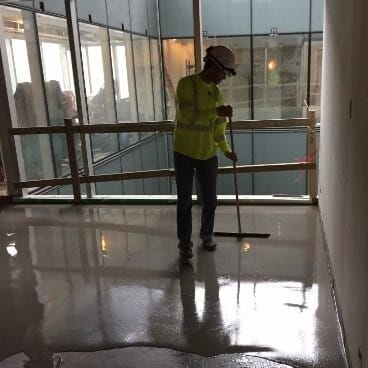Concrete floor finishes are becoming increasingly popular; they’re durable, affordable, customizable, and low maintenance. Different concrete floor finishes can all have different properties; let’s explore some of the finishes available:
Why Does the Concrete Finish Matter?
Concrete surfaces come in a variety of finishes. These finishes affect everything from their durability to their aesthetics.
The concrete finish you choose will have a dramatic effect on the look, feel, and function of your flooring. Each type of finish is so distinct that it can be considered an almost totally separate type of flooring.
Your Flooring Needs and Preferences
When choosing a concrete floor finish, you’ll need to consider:
- How much time, effort, and money you’re willing to put into maintenance
- Your aesthetic needs
- The level of traffic the flooring will get
- The type of traffic the flooring will get
- Exposure to chemicals, abrasives, and other potentially damaging substances
- Your budget
- And more
As we explore each type of concrete finish, you’ll get a better idea of which flooring will suit all of your needs.
Exploring Different Finish Options
1. Exposure – Class A: Cement Fines or “Cream Polish”
Class A finishes aim to create smooth texture with aesthetic appeal. They’re known as cement finishes because of the cement paste used on the outermost layer of the concrete; The cement fines finish typically exposes only the sand particles in the concrete floor. This finish is considered a “creamy looking” surface with no aggregate exposure.
While Class A finishes are the most cost effective, because they are faster because there is less “cutting” of the concrete. Class A final appearance is highly dependent on how the concrete installer and finisher finishes the concrete while curing. Special attention also needs to be done on placing the concrete as flat as possible to avoid any low or high spots.
Due to the quicker installation and budget friendly costing, we see this install in large areas like warehouses.
2. Exposure – Class B: Fine Aggregate or “Salt and Pepper”
Class B is the most specified exposure. The surface of the concrete is lightly ground, exposing the smallest aggregate in the concrete mix. While this finish is often used in new residential construction, it is extremely widespread in commercial or industrial applications.
If adhesive removal needs to be done from existing previous flooring, Class A cannot be achieved, but Class B can be.
3. Exposure – Class C: Coarse Aggregate
Class C typically exposes the greatest amount of aggregate in the concrete floor. This is mostly used when special aggregates are “seeded” into the concrete mix, like glass, specialty stone, etc. This is also used when concrete needs to be restored and requires a deeper cut. This could include the removal of 1/8 to 1/4 inch.
4. Gloss Levels for Polished Finishes
In general, three gloss level finishes above can all be used on the three different exposures. ALso noting that polished concrete will dull over time, with washing and use.
Level 1: Flat (Ground)
Level 1 can only barely be considered polished concrete—it may be more accurately referred to as ground concrete. There’s very little reflection or clarity, giving a matte look and a slip-resistant surface. The surface of the concrete is ground away using diamonds; generally, grinding is stopped at about 100 grit.
Typically, flat finishes are used in industrial floors and other locations where a glossy aesthetic is not desired.
Level 2: Satin (Honed)
Level 2 offers a satiny appearance. It has more reflectivity than Level 1, offering some gloss and shine without the risk of glare. The surface is smooth, and diamond abrasives up to about 400 grit are utilized.
Satin or honed finishes are often used in residential areas and some commercial spaces; they’re also commonly used in spaces where gloss is to be avoided, like libraries and educational facilities.
Level 3: Polished
Level 3 polished concrete floor finishes provide higher gloss; light and images are reflected by the floor, and they provide a high level of shine. By Level 3, polished concrete flooring is so reflective that you may need fewer lights to illuminate your environment. Usually, grit levels of up to 800 are used.
This style of floor is typically reserved for commercial and retail environments; polished floors can reduce overhead costs while providing a more aesthetic shopping experience.
Level 4: Highly Polished
Level 4 polish is achieved through the use of up to 3000-grit diamond polishing. Highly polished floors shine with a mirror-like sheen, reflecting images and light with astounding clarity. They’re often used in high-scale retail and commercial environments, where aesthetics take precedence over cost; car dealerships, jewellers, and other high-end stores will often take advantage of highly polished concrete floor finishes.
Factors To Consider in the Decision-Making Process
1. Budget Considerations
Budget is one of the primary concerns when considering a concrete floor finish. First, consider the upfront costs of installing the type of concrete floor you want; from there, think about the ongoing maintenance costs. Finally, consider how the different types of concrete floors can increase sales, lower liability, and affect other financial markers.
A polished concrete finish gets more expensive with the depth of the cut or aggregate exposure. There’s no one-size-fits-all concrete solution; consider costs and benefits when choosing your floor.
2. Timeline and Installation Process
Generally, Class A finish is the quickest and easiest to install. A polished concrete floor finish will take longer to install as the depth of cut increases, with a deep grind polished floors taking the longest to install. If there are many rooms, polishing before interior stud installation makes it quicker, provides a better finish and is less expensive. Smaller rooms require more hand polishing and there are more edges to hand polish, while large spaces large grinders can be used to create a better, even finish.
3. Consulting With Professionals
The best way to understand which concrete surface will work best for your floors is to consult with a professional. Depending on the use of your concrete floors, the aesthetics you’re trying to achieve, and your budget, they’ll be able to recommend different concrete floor finishes to suit your needs. At TCF West, we’ve installed hundreds of concrete floors for businesses, residences and warehouses of all kinds; we can help you.
Conclusion
There are several different concrete floor finishes available, and the one that will be right for your business will depend heavily on various factors, from the level and type of traffic in the area to your aesthetic goals.
We’ve only scratched the surface—so many different kinds of modifications can be made to these floors: Stained concrete flooring, and inlays can add colour to your floors. Logos can be integrated into concrete flooring. Various aggregates can be integrated to match your aesthetic needs.
Whether you’re looking for a shiny surface or an exposed finish, there’s a style of concrete flooring that’s right for you. The possibilities are almost endless; talk to one of our consultants today!


